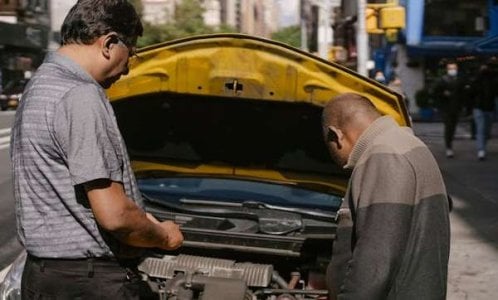Drive safe: New road rule may combat roadside danger for millions of Aussies
By
Danielle F.
- Replies 0
Driving around Australia can be a fun experience, especially for seniors who love to go outdoors.
Yet, the recent rise of vehicular accidents has deterred many Aussies from enjoying the open road.
For motorists in one state, an existing rule has seen a new update that may make roads safer not just for drivers but also for other people on the road.
A new law will require motorists in Victoria to slow down to 40 km/h when passing by incident response vehicles.
This change was a significant extension of the existing rule, which already applies to police cars and ambulances with flashing lights.
The move came after years of campaigning by roadside worker groups and the Royal Automobile Club of Victoria (RACV).

Advocacy groups highlighted the dangers faced by those working on the side of busy roads.
According to a recent RACV survey, 83 per cent of roadside workers have experienced a near-miss with a passing vehicle at least once a week.
‘I had a vehicle that almost hit me, and I’ll tell you what, it was really scary,’ RACV Patrol Officer Johnny Dipietro shared his own harrowing experience.
Incident responder Steven Bevens echoed Mr Dipietro’s sentiment, stating close calls are ‘an everyday occurrence for our staff’ when they’re pulled over on the shoulder of a busy road.
Starting Tuesday, 1 July, drivers need to slow down to 40 km/h when nearing tow trucks, roadside assistance vehicles, and mechanic vehicles attending breakdowns.
Failure to slow down could result in a $346 fine, which could rise to $961 depending on the severity.
As of writing, the offence will not have any demerit points but may change in the future.
Victoria is one of the last states to introduce this rule, following the footsteps of South Australia, New South Wales, Queensland, Tasmania, Western Australia, and the ACT.
This means the Northern Territory is the only Australian jurisdiction without a similar law.
It’s easy to forget how dangerous the roadside could be for workers.
Whether it’s a tow truck driver helping a stranded motorist or a mechanic changing a tyre, these workers are centimetres away from fast-moving traffic.
A moment’s inattention from a passing driver could have tragic consequences.
‘It is making sure they’re safe when they’re out there working on our bustling roads,’ Victoria’s Road Safety Minister Melissa Horne emphasised.
For seniors planning to travel interstate soon, similar rules apply in most other states and territories.
The specifics may vary, but the message is the same: slow down and give space to those working on the roadside.
Remember, a few extra seconds of caution could make all the difference.

Have you or someone you know ever had a close call with an incident vehicle on the side of the road? Will this new rule make a difference? We would love to hear your thoughts and stories in the comments section below.
Yet, the recent rise of vehicular accidents has deterred many Aussies from enjoying the open road.
For motorists in one state, an existing rule has seen a new update that may make roads safer not just for drivers but also for other people on the road.
A new law will require motorists in Victoria to slow down to 40 km/h when passing by incident response vehicles.
This change was a significant extension of the existing rule, which already applies to police cars and ambulances with flashing lights.
The move came after years of campaigning by roadside worker groups and the Royal Automobile Club of Victoria (RACV).

Roadside mechanics tending to emergency repairs may feel safer with the new rules. Image Credit: Pexels/Tim Samuel
Advocacy groups highlighted the dangers faced by those working on the side of busy roads.
According to a recent RACV survey, 83 per cent of roadside workers have experienced a near-miss with a passing vehicle at least once a week.
‘I had a vehicle that almost hit me, and I’ll tell you what, it was really scary,’ RACV Patrol Officer Johnny Dipietro shared his own harrowing experience.
Incident responder Steven Bevens echoed Mr Dipietro’s sentiment, stating close calls are ‘an everyday occurrence for our staff’ when they’re pulled over on the shoulder of a busy road.
Starting Tuesday, 1 July, drivers need to slow down to 40 km/h when nearing tow trucks, roadside assistance vehicles, and mechanic vehicles attending breakdowns.
Failure to slow down could result in a $346 fine, which could rise to $961 depending on the severity.
As of writing, the offence will not have any demerit points but may change in the future.
Victoria is one of the last states to introduce this rule, following the footsteps of South Australia, New South Wales, Queensland, Tasmania, Western Australia, and the ACT.
This means the Northern Territory is the only Australian jurisdiction without a similar law.
It’s easy to forget how dangerous the roadside could be for workers.
Whether it’s a tow truck driver helping a stranded motorist or a mechanic changing a tyre, these workers are centimetres away from fast-moving traffic.
A moment’s inattention from a passing driver could have tragic consequences.
‘It is making sure they’re safe when they’re out there working on our bustling roads,’ Victoria’s Road Safety Minister Melissa Horne emphasised.
For seniors planning to travel interstate soon, similar rules apply in most other states and territories.
The specifics may vary, but the message is the same: slow down and give space to those working on the roadside.
Remember, a few extra seconds of caution could make all the difference.
Key Takeaways
- From 1 July, Victorian motorists must slow down to 40 km/h when passing incident response vehicles, such as tow trucks and roadside assistance.
- The rule aimed to improve the safety of roadside workers, following consistent reports of near misses at least once a week.
- Drivers who fail to slow down face a standard fine of $346, with a maximum penalty of $961.
- Northern Territory remains the only Australian jurisdiction without a similar law in place.







